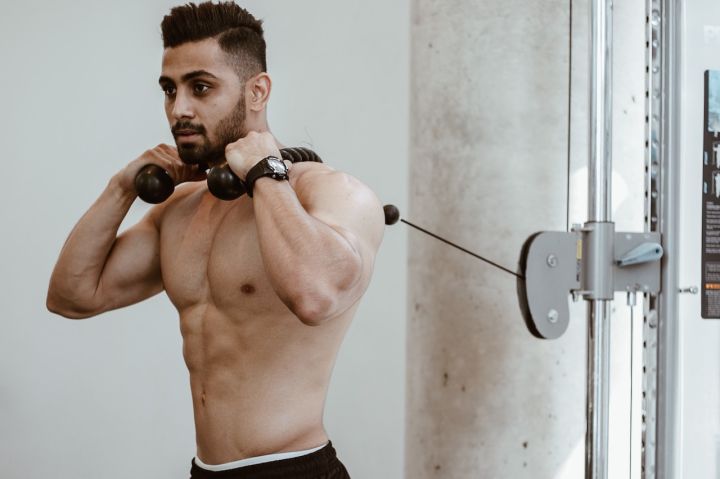for a male, how can you not want to have thicker arms, as can be seen by the appearance of the movement, the behind-the-neck dumbbell arm flexion is a very popular one.

The behind-the-neck dumbbell arm curl is a great isolation move for the triceps, which is difficult to lend strength to, not to mention not being able to crave large weights. As a result, many people focus on how to "Plunge" The dumbbells and neglect the elbow position and the stroke of the movement, which can look hard and ineffective. Today we will explain this movement in more detail.

how to perform the behind-the-neck dumbbell arm curl
1. Choose the right weight for the exercise. Only one dumbbell is needed as this is a single dumbbell training movement. If doing this movement for the first time, choose a conservative weight, one that can be safely lifted for 8 to 12 reps.
If you are unsure about the weight, choose a conservative weight and then gradually increase it to ensure that you can get into the correct position for the movement at the start of the workout. Although this movement can be done standing, research has found that a seated position provides better isolation to stimulate the target muscles.

2. Having chosen the appropriate training weight, hold the dumbbells and place them next to a flat bench or shoulder press chair, while adjusting the upper incline bench to an upright position may affect range of motion.
3. Sit on the bench so that the gluteus maximus can safely rest on the pad and the calf is then perpendicular to the floor. Pick up the dumbbells and hold them firmly. The safest way to hold the dumbbells in this movement is to turn them over vertically with the tiger grip on the dumbbell piece, knuckles to yourself, supporting the inner portion of the upper end of the dumbbell.

at this point, one hand may slightly cover the fingers of the other hand.
4. With the dumbbell securely in your grip, straighten (but do not hyperextend) your arms and elbows with the dumbbell over your head, in line with your ears and shoulders. Keep your upper body neutral, chest up and shoulders down, this is the starting position for the movement.

5. Take a deep breath, tighten your core and begin to lower the dumbbells behind your head. By bending the elbows, move the forearms downwards while keeping the upper arms as vertical as possible. Keep your wrists stationary so the dumbbells don't wobble around.
Continue lowering the dumbbells and feel a good stretch in the triceps. Hold the forearm at a 45-60 degree angle to the floor, keeping this as the lowest point, and stretch for 1 to 5 seconds. Squeeze the triceps and lift the dumbbells upwards, with the dumbbells above the ears and shoulders, lower and repeat, completing the corresponding number of movements.

the path of movement for lowering and lifting the dumbbell should be the same. The upper arms and elbows should be in a fixed position throughout the movement. If you notice excessive outward opening of the elbows or significant swaying of the upper arms, then too much weight is being used.
Some fitness enthusiasts prefer to exhale on the return stroke or between movements. It is recommended to just choose a breathing style that is the most natural and comfortable.
The behind-the-neck dumbbell arm extension can be practised by choosing the pre-fatigue method, decreasing sets, stopping sets, supersets, giant sets, pause sets, half sets, forced sets, etc.

as with other movements, the two most important things to remember about the behind-the-neck dumbbell arm extension are a high quality movement position and a progression of weight. There are many more ways to add to the training process (more weight, more sets, more reps, shorter rest periods, etc.), but strive to improve the quality of each workout.
Posture tips for behind-the-neck dumbbell arm curls
1. Feel the stretch
if you want to increase the intensity of the exercise by pausing at the lowest point of the movement, try holding the elbow extension position for 5 to 10 seconds. Focus on squeezing the triceps and do not relax at the lowest point.

this increases the amount of time the muscle is under tension and gives the triceps a strong stimulus. Keeping the muscle under tension is a good way to adjust the load and strengthen muscle growth according to this.
2. Avoid borrowing force
the behind-the-neck dumbbell arm curl delivers maximum training results when the entire movement stroke is under control. Do not be overly ambitious when training with more than 30 kg of dumbbells at once.

keep your body tight (tighten your hips, keep your upper body upright, lift your chest and lower your shoulders) and do not use borrowed strength to lift the dumbbells from their lowest position to recover. This will greatly increase the potential for injury and weaken the stimulation of the target muscles.
Also, be especially careful if you have shoulder problems when doing this movement, as this movement may exacerbate the underlying fault.

training of the arms should pay more attention to the triceps, which are after all two-thirds of the volume of the upper arm, and strong arm curves are trained step by step.

